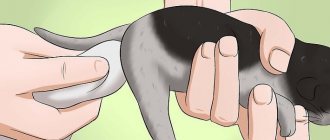Features of training
It’s worth noting right away that you need to gain strength and patience, since this process very rarely goes quickly.
In general, cats are quite clean creatures, although they are often capricious, but they are very sensitive to the issue of toileting.
They usually choose hard-to-reach corners as an ideal place to defecate, so during the period of getting to know the new home, it is advisable to close all the spaces under the furniture so that the cat does not get through there.
Some people mistakenly believe that training an adult pet is much easier than training a kitten, but this is not at all true.
Each animal has special character traits, in particular adults, who have already formed and developed certain habits regarding going to the toilet.
A cat that has lived on the street for some time is accustomed to doing its business literally under every bush and in other corners inaccessible to prying eyes.
The first and most important point is the installation location of the tray.
It should be easily accessible, but at the same time isolated so that the cat can retire there. A corner in the bathroom or on a warm balcony is perfect. For obvious reasons, it is not worth placing the tray in the passage corridor, and especially in the kitchen.
If this is a full-fledged house with walls and a roof, an exception can be made.
During the first time your cat is in the house, it is better to keep him in a closed room to avoid the temptation to mark new territory.
Nuances of catching
Adult cats are afraid of humans and it is not easy to catch them. As a rule, at the sight of animal shelter workers, these creatures flee for their lives, hiding in bushes, basements and other nooks and crannies. That is why, if you decide to catch a cat, take with you an old blanket or a fishing net.
When your catch is in the nets, take it home and place it in a box prepared in advance for this purpose. Place a regular tray not too far away - let the animal sniff and get used to it a little. If possible, allocate a separate room for the newcomer or place him in the bathroom. Let him stay in a closed area for the first time: this will help him relax a little. If you have a small apartment, place the kitten in a cage and cover it with a blanket. In any case, your main task is to create a calm environment for the animal.
We recommend this article:
How to easily train a kitten or adult cat to go to the litter box
Choosing a tray and filler
You need to select a suitable container based on the size of the cat so that it can safely dig there. The height of the side can be different and the higher it is, the better, but 10 cm is considered the golden mean.
If the pet has previously had owners, you can ask them which litter box the pet went to.
You can purchase a full-fledged house in which the cat can retire and be in its comfort zone. Such trays have both an advantage in the form of built-in absorbent filters and a disadvantage in the difficulty of caring for them.
The most common and budget-friendly are ordinary plastic boxes; the same ones, but with an insert mesh at the bottom, are a little more expensive.
Which type is right for a particular cat can only be determined through trial and error.
A very important role is played by filler, of which there are many types on the shelves of pet stores.
It can be wood filling made from compressed sawdust, clumping, absorbent, mineral, silica gel or made from cellulose waste.
Here it is worth making a choice based on the recommendations of friends or veterinarians, the type of filler and its cost.
Trial and error will also allow you to find exactly what suits your cat.
By the way, some pets prefer either no filler at all, or pieces of newspaper placed on the bottom.
However, such options are not entirely hygienic, since the cat’s paws can play the role of filler here, which will constantly get dirty.
Taming Rules
If a cat is not given to a person at all, it is necessary to accustom it to contact gradually.
Pour food into a bowl and place it outside the cage - this will force the kitten to come out of its hiding place. Then gradually move the bowl to the middle of the room. When the pet begins to move further, try petting it and then feed it.
The next stage in taming an animal is the tray. Stray cats relieve themselves on the sand or ground. That's why fill your cat's litter box with sand first. Every time the kitten starts to fuss, put him in the litter box. Thus, he will soon understand what his purpose is. Over time, replace the sand with purchased filler. Of course, sometimes cats are so stressed that they may urinate in inappropriate places. But any experience is temporary.
How to accustom a cat to hands and affection
If you want cat affection, become patient and affectionate yourself. An outdoor cat will begin to trust a person when it gets used to his smell and voice. He will associate his appearance with a pleasant event (food, affection).
A wild cat is tamed in the same way as a kitten. First, treats are brought regularly. Then they hold out their palm with a piece of the most delicious thing (the delicacy lies in the center of the palm, not on the fingers!), and allow it to be sniffed. When the cat begins to approach, perhaps rubs its head on its leg, you can pet it in response, speaking calmly and affectionately.
A common mistake: in order to tame a cat at home, he is immediately locked in a room - the animal will try to escape as soon as it is freed.
You can call the cat with you, after a few meters, stop, praise, and give a treat again. The main thing is that if you come, give her the opportunity to leave. Without feeling afraid, the pet will return.
First actions
When the pet is in the house, he needs to be given some time to get used to it in a dark corner. At first, you should not disturb him or touch him with your hands. But some procedures must be carried out almost immediately, without delay. First, you need to check your nose and eyes - discharge from them indicates the presence of infection. Secondly, you should wash the animal using a special shampoo for kittens to get rid of ectoparasites. Be prepared for the fact that the kitten is not accustomed to such procedures and therefore will bite and scratch.
The pet will need to be shown immediately to a veterinarian so that he can determine its age, take the necessary tests and advise on vaccination, feeding and care.
Wild kittens
If it's a kitten born to a domestic cat and somehow separated from the normal pack, it's probably not that wild. Therefore, taming him should not be a problem. But if he is a "hereditary savage", he will have to deal with you, because he will equally fear you and distrust you, even if you feed him.
Determine your age
In principle, this point can be omitted, since veterinarians determine age almost accurately. But if you're also interested, you can do it right now with your eyes and teeth (or missing teeth).
Kittens usually open their eyes 10-16 days after birth. Sometimes kittens have one eye larger than the other, which can only mean the process is incomplete and therefore the kitten is about 2.5 weeks old. Even kittens without blue or gray eyes are blue or gray. Eye color changes to a permanent color from the 2nd to the 3rd month inclusive.
Kittens also gradually develop baby teeth:
If you can only see the front incisors, the kitten will look no more than 3-4 weeks old; If there are teeth on the sides, he will be around 5-6 weeks old; And if you see fangs, your kitten will be 7-8 weeks old.
Possible problems that arise during the training process
There are situations when an adult animal refuses to use the tray, although until recently it willingly did everything. You should not immediately scold the cat; it is better to consult a veterinarian. Since such behavior often indicates health problems. Sometimes this simply means the tray is inappropriate or in the wrong location.
Trust your cat to choose a location for the litter box.
Keep the toilet relatively clean. Since many animals cannot stand dirty trays and will meow demandingly when the potty turns out to be dirty.
Most animals are owned. This means that they do not like to share the toilet with anyone. Therefore, if you do not want animal conflicts, purchase as many trays as you have pets.
It is very difficult to say definitively whether you can train your cat to use a litter box; it all depends on the individuality of the animal.
Although there is nothing impossible in this world. Because there is a desire, and everything else will follow. Be persistent and persistent in training your cat to use the litter box, only then everything will work out over time.
Over time, he will begin to understand that a person does not wish evil.
When your pet begins to trust you, you can start picking him up, stroking him behind the ear and tickling his belly. In addition, he must gradually be accustomed to games. If a kitten scratches you, he should say “no” in a stern tone and leave.
By patiently and systematically performing such manipulations, in three days you will receive an affectionate and domestic cat. If your new friend has begun to trust you, then you can start introducing him to the rest of the family and letting him near the children. An adult wild cat can be domesticated in about a week. The main thing is to be patient and radiate warmth and love, because animals feel everything.
How to get a kitten used to eating from your hands.
When you want to feed your kitten, talk to him in a soft, calm voice. Try to hand feed him, but if he is afraid, don't insist. He may need to get used to your presence.
With your palm outstretched, offer something warm and flavorful, such as chicken. It's quite rare for a kitten to refuse food when the food smells so delicious. But if this does not happen, you can safely leave the room with food for a while
Don't leave your kitten without support if you see progress in his behavior. For example, if your kitten stops being aggressive but still refuses to eat from your hand, you can simply stick your hand into the cage and praise him quietly and gently. And when you remove your hand, leave a good piece of food in the cage and walk away.
If you want to hand feed your kitten, never make sudden movements and always be consistent in leaving the room with the food. And only when your kitten begins to take food out of your hands, do you start stroking it.
Mineral cat litter
Granular fillers (for example, “Fresh Step”, etc.) absorb moisture and odor well. Due to this, a lump is formed, which can be removed using a child's spatula.
Reviews about it are only good, because this filler not only removes odors, but also does not stick to the animal’s paws. The granules in the litter have different sizes, so each cat will be able to choose the right one.
Among the disadvantages: it cannot be used for small kittens and it is undesirable to throw it into the sewer.
What should the filler be?
The requirements for a litter tray for a kitten are as follows: environmentally friendly, not dirty for the baby’s paws, without a strong odor, able to moderately contain the odor.
Let's evaluate the most popular fillers.
- Silica gel. It blocks odor well, the cat's paws remain clean and have no odor. But! If this composition gets into the kitten's digestive tract, it is dangerous to its health.
- Woody. It copes well with masking the smell, does not stain the paws, and is not dangerous for accidental entry into the esophagus. It has a faint smell of pine, most cats either don’t care or even like it. But some cats flatly refuse to go to such a toilet.
- Mineral. Odor masking is almost zero. The paws get dirty, it is not dangerous for the cat’s health, it has no smell.
- Clay. Contains the smell of urine, the paws get dirty, it is not dangerous for the digestive system, and the smell does not irritate the pet.
- Corn. Almost copes with masking the unpleasant odor. But small particles of litter can stick to the kitten’s paws and spread around the toilet. If accidentally ingested, it is harmless.
- Paper waste. Doesn't retain odor well, doesn't stain paws, is harmless to the animal's gastrointestinal tract, and has no odor.
If you are adopting a kitten from a home where it has already used the litter box, you should use the same type of litter. Subsequently, it can be changed, but for a new habituation this is not necessary. Wood and corn litter are chosen more often; it is believed that they are more suitable for kittens. Be sure to monitor the kitten's condition: an allergic reaction is not excluded.
Sometimes a cat refuses to go to the toilet because there is too little litter. This method of covering his tracks seems unconvincing to him, and he continues to look for a better place.
Finally, do not buy a very expensive filler: the expenses are not one-time, but systematic, and it will not be very easy to change later. The product must be accessible; if purchasing it involves searching throughout the city, avoid unnecessary complications.
Getting your pet used to the house
Even before you are ready to bring your new pet home, you should set up a separate place for it. A separate room is best suited for this, and if it is not available, a spacious cage or an insulated balcony. In the chosen place you need to place a soft blanket, a lounger, bowls of food and water, a tray, several toys and any things with your scent.
Getting to know the home
When you return home, place the carrier or catsuit in a pre-prepared room. Open the lid and let the animal take the first step into unfamiliar territory.
If you choose a cage, cover it with some fabric, and if you choose a whole room, close the curtains. Dim lighting will make it easier for your cat to relax. After this, leave the room for 2-3 hours, leaving the animal alone.
To be safe, be sure to remove fragile or heavy items from shelves and be sure to cover any holes that could be crawled into. Pay special attention to the wires. They need to be lifted off the floor and isolated so that the cat cannot be injured.
Feeding and litter box
After the time indicated above, return to the room and try to offer something tasty by extending your hand. If the cat stubbornly refuses to contact you, put the food you brought in her bowl.
When further feeding, be sure to adhere to the regimen. Give food at the same time in small portions so as not to overload the stomach of a hungry animal on the street.
During feedings, stay in the room, but do not try to get close. The best option is the corner opposite from the cat, where she can clearly see you. You can try hand feeding again as soon as she stops hiding in your presence.
“ Pay special attention to water. Outdoor animals often become dehydrated, so be sure to monitor the amount of water in the bowl and remember to change it for a new one.
It is better to get acquainted with the tray using ordinary soil. Unlike the filler, it has a familiar smell, and at the adaptation stage it is important for you to get accustomed to a certain place. Over time, the land can be replaced with something else.
Gradual socialization
To avoid stress, don't try to make too many contacts in one day. First, let your cat get used to you and the new place. Feed her, communicate and try to engage her in play. As soon as she begins to trust you, expand your social circle with the help of other adults in the household.
At the next stage, you can move on to meeting the children. Explain to them that the new pet cannot be touched against its will, and also ask them not to make noise.
At the very end, get accustomed to other animals living in your home. At an earlier stage, a conflict over territory may arise between them, so you should not strain the frightened “mustache” before it gets comfortable.
Security measures
It is recommended to immediately take a cat caught in a trap to a veterinary clinic. There she will be examined for external injuries, given an anti-worm tablet and vaccinated against the most common infections. Thanks to this check, you will exclude infection of other pets and yourself.
When you get home, do not rush to pick up your pet. At the stage of getting used to the house, it is better not to provoke the animal, as fear and stress can develop into defensive aggression. For the first 14 days, it is recommended to isolate him in a separate room to allow him to get acquainted with new smells and make sure there are no hidden pathologies.
IMPORTANT!
Don't forget about washing. The easiest option is to pay for this service at a veterinary clinic or grooming salon.
If fleas or other parasites are confirmed, be sure to disinfect the room and wash your hands after each contact with the “whisker” until recovery. At the stage of accustoming to hands and affection, wear thick clothes with long sleeves and wear gloves to protect yourself from parasites and attacks from the cat itself.
Games and "tenderness"
You can start playing with the kitten after he gets used to you. However, he does not need to be forced to communicate with you. Some people don't like being petted or held on their laps at all. It all depends on the cat’s temperament, the character and lifestyle of its distant ancestors. You can buy toys for games.
Some tame wild cats and do not show affection towards their owners, even though they may sleep next to each other, sometimes sit on their laps or play with them. You can also benefit from this because they are unobtrusive, don't get underfoot, and there is no need to entertain them.
WHAT YOU NEED TO KNOW. About parasites.
It would be naive to assume that a wild kitten does not have parasites. You can be sure that he has enough of them, both external and internal. And the first desire of many beginners is to immediately wash the kitten with a shower. You will do this a little later as it may make your kitten more stressed.
First let your kitten get used to the new diet and feed him, as you may not know when he last ate.
The ideal solution would be to visit a veterinarian, who will not only conduct a thorough examination for the presence of parasites, but also visually verify that there are no signs of disease. The doctor will also correctly prescribe medicine against infection.











